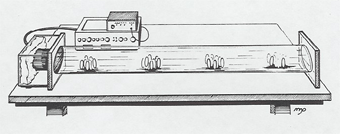- 1. Mechanics
- 2. Harmonic Motion, Waves and Sound
- A. Simple Harmonic Motion
- B. Waves
- C. Acoustics
- 10. Effects of Sound
- 10. Acoustical Interference
- 20. Acoustical Perception
- 30. Beats and Sympathetic Vibration
- 40. Bell in Vacuum
- 50. Breaking Glass with Sound
- 60. Chladni Plate
- 70. Doppler Shift
- 80. Flame Tube
- 90. Helmholtz Resonator
- 100. Kundt's Tube
- 110. Rijke Tubes
- 120. Rudnick's Acoustical Cavity and Motor
- 130. Science of Sound Tape
- 140. Voice with Helium
- 20. Musical Instruments
- 10. Effects of Sound
- 3. Matter and Thermodynamics
- 4. Electricity and Magnetism
- 5. Light and Optics
- 6. Modern Physics
- 7. Astronomy
- 8. Software and Multimedia
- 9. Index and code conversion from older manual
- External Resources
100. Kundt's Tube

Our large Kundt's tube, designed by Prof. Rudnick, dramatically demonstrates standing acoustical waves. See the animation of standing waves in the waves section of the demo manual. Additional demonstrations and accessories with this apparatus are:
- Microphone probe connected to an oscilloscope to accurately determine positions of the pressure antinodes. Using a frequency counter to measure the exciting frequency and the measured distance between the antinodes, you can determine the speed of sound to within 1%.
- Hot wire probe (designed by S. Baker) detects the position of the velocity antinodes (which are at the position of the pressure nodes). The observed frequency on the scope is twice the exciting frequency since the probe responds to the square of the velocity. A pressure gradient mike is scheduled to replace this.
- Acoustical levitation: the tube can be stood upright to levitate the Styrofoam chips or a single light disc at about 30 watts of input power.
- Bernoulli effects: Two Styrofoam balls arranged laterally in the tube at a velocity antinode attract, while two balls arranged longitudinally repel. The fact that the discs in the illustration at the top arrange themselves perpendicular to the particle velocity is also a Bernoulli effect, explained briefly in Rudnick's Acoustical Cavity and Motor.
- "Cooper pairs": - balls at different antinodes oscillate together in the sound field.

